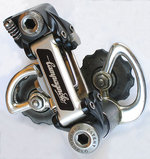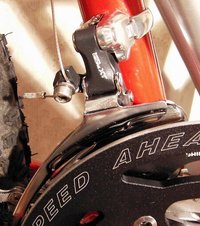Derailleur gears
| Transmission types |
|---|
| Manual |
| Continuously variable |
| Bicycle gearing |
Derailleur gears are a variable ratio transmission system commonly used on bicycles, consisting of a chain, multiple sprockets and a mechanism to move the chain from one sprocket to another. Although widely referred to as "gears", bicycle "gears" should properly be referred to as sprockets since they are driven by, or drive, a chain; and are not driven by one another.
Modern front and rear derailleurs typically consist of a moveable chain-guide that is operated remotely by a Bowden cable attached to a shift lever mounted on the down tube, handlebar stem, or handlebar. When a rider operates the lever while pedaling, the change in cable tension moves the chain-guide from side to side, "derailing" the chain onto different sprockets. Both to guide the chain to the selected sprocket and to maintain chain tension by taking up any slack caused by changing to a smaller sprocket, the rear derailleur has two pulleys in a spring-loaded rotating cage, through which the chain rolls in an S-shaped pattern. The pulleys are known as the guide pulley (top) and the tension pulley (bottom). Together they are commonly referred to as the jockey pulleys or wheels. The front derailleur has a cage that should touch the chain only while shifting between the front chainrings.
History
Various derailleur systems were designed and built in the late 1800s. The French bicycle tourist, writer and cycling promoter Paul de Vivie, aka Velocio, (1853-1930) invented a two speed derailleur in 1905 which he used on extensive forays into the Alps. Some early designs used a system of rods to move the chain onto various gears. Derailleurs did not become common road racing equipment until 1938 when Simplex introduced their cable shifted derailleur. In the early 1950s the cable-operated, parallelogram variety used on today's bicycles was introduced by Tullio Campagnolo, who also invented the quick release skewer for attaching the wheels. With Campagnolo's introduction of the parallelogram derailleur, Campagnolo became the standard for high quality derailleurs for several decades with its Gran Sport, Record, Super Record gears. Before the 1990s many other manufacturers also made derailleurs, including Simplex, Huret, Galli, Mavic, Gipiemme, Zeus, Suntour, and Shimano. However with introduction of indexed gears which required all parts of the drivetrain to be specifically compatible, and the increasing use of complete groupsets made by one company, today Campagnolo and Shimano are the two main manufacturers of derailleur gears, with Campagnolo only making road cycling derailleurs and Shimano both for road and mountain bikes. American manufacturer SRAM specializes in derailleur systems for mountain bikes, but as of 2006 SRAM has introduced a drivetrain system for road bicycles.
In 1964, Suntour invented the slant-parallelogram rear derailleur, which allows the jockey wheels to maintain a more constant distance from the different sized sprockets, resulting in easier shifting. Once the patents expired, the other manufacturers adopted this design, at least for their better derailleur models.
Modern derailleur types
The major innovations since then have been the switch from friction to indexed shifting and the gradual increase in the number of gears. With friction shifting, the rider first moves the lever enough for the chain to jump to the next sprocket, and then adjusts the lever a slight amount to center the chain. An indexed shifter has distinct clicks for each gear, and the rider merely moves the lever to the click they want without a second adjustment movement. However, indexed shifters can be difficult to re-calibrate when cables stretch or when pieces are swapped out. On racing bicycles, 10-gear rear cassettes are appearing as of 2000 for a total of 20 or 30 gears. Most current mountain bicycles have three front chainrings; while road bicycles may have two or three. Many road cyclists will rarely use the smallest ring and opt for two rings to reduce weight, especially if they are participating in a race. Derailleur gears are the most common type of gears used on bicycles today.
Rear derailleurs
- High-normal rear derailleurs when no cable tension is applied will return to the smallest cog on the cassette. Most Shimano mountain, all Shimano road, and all SRAM and Campagnolo derailleurs are high-normal designs.
- Low-normal rear derailleurs for mountain bikes are manufactured by Shimano. These derailleurs, introduced in 2004 in the XT and XTR groups maintain position over the largest cog on the cassette when no cable tension is applied. From a user interface point of view they shift opposite to other mountain bike derailleurs. The user 'clicks' the index finger trigger to move to a larger cog, and pushes with the thumb trigger to select a smaller cog.
- The distance between the upper and lower jockey wheels of a rear derailleur is known as the cage length. The capacity of a derailleur to take up chain slack is dependent on its cage length. This varies depending on the size difference between the largest and smallest rings on the crankset. Typical cross country mountain bikes with three front chainrings will use a long cage rear derailleur. Shimano and Campagnolo road derailleurs are available in either short, medium or long cage versions, for use with double or triple front cranksets and various cassette ratios. Some mountain bike derailleurs are also available in an extra-short cage length, typically used with a single fixed front ring such as found on downhill mountain bikes.
- There are at least two methods employed by rear derailleurs to maintain the appropriate gap between the upper jockey wheel and the rear sprockets as the derailuer moves between the large sprockets and the small sprockets.
- One method, used by Shimano, is to use chain tension to pivot the cage. This has the advantage of working with most sets of sprockets, if the chain has the proper length. A disadvantage is that rapid shifts from small sprockets to large over multiple sprockets at once can cause the cage to strike the sprockets before the chain moves onto the larger sprockets and pivots the cage as necessary.
- Another method, used by SRAM, is to design the spacing into the parallelogram mechanism of the derailleur itself. The advantage is that no amount of rapid, multi-sprocket shifting can cause the cage to strike the sprockets. The disadvantage is that there are limited options for sprocket sizes that can be used with a particular derailleur.
- There are at least two conventions for the relationship between shifter travel and derailleur travel, known as actuation ratios.
- One convention, used by Shimano, is one-to-two (1:2). Each millimeter of cable moved in the shifter causes two millimeters of movement at the derailleur.
- Another convention, used by SRAM, is one-to-one (1:1). Each millimeter of cable moved in the shifter causes an equal millimeter to be moved in the derailleur. SRAM claims that this makes their systems more robust: more accepting of contamination.
- Shifters employing one convention are not compatible with derailleurs employing the other, and visa-versa. SRAM does make shifters, often labeled with MRX, that are compatible with the 1:2 actuation ratio.
Front derailleurs
- E-Type front derailleurs are attached to the frame by a plate mounted under the drive side bottom bracket cup and a screw threaded into a boss on the seat tube. These derailleurs are usually found on mountain bikes with four or more inches of rear suspension travel.
Alternative gear systems
An alternative type of gear system used on bicycles is hub gears, which were popular on utility bikes until the 1970s, when derailleur systems became available in lower-priced bikes. Hub gears are still very popular in Europe, as the gear can be changed when the bike is stationary, which makes them suitable for riding in city traffic with lots of stops and starts. The gears are also enclosed in the hub, and consequently require less maintenance. However, they usually have a smaller number of transmission ratios (i.e. speeds), although lately a 14 speed internal hub gearing system became available, with a gear range as wide as a mountain bike's 27-speed derailleur system, the Rohloff Speedhub.
Multi-speed versus single-speed
Some Fixed-gear and single-speed cyclists eschew the use of derailleurs, favoring a simpler, more rugged configuration, with fewer or no cables. They enjoy quoting Henri Desgrange, the founder of the Tour de France:
- "I still feel that variable gears are only for people over forty-five. Isn't it better to triumph by the strength of your muscles than by the artifice of a derailer? We are getting soft...As for me, give me a fixed gear!" (L'Équipe article of 1902)
- The Dancing Chain - History and Development of the Derailleur Bicycle. Frank Berto, Ron Shepard, and Raymond Henry. 2000. Van der Plas Publications, San Francisco, CA. ISBN 1-892495-21-X
See also
- Single speed bicycle
- Fixed gear bicycle
- List of bicycle parts
- Shifter (bicycle part)
- Gear inches
- Bicycle gearing
External links
- Bicycle Repair in Wikibooks
- A Brief History of the Derailleur by John Forester
- Derailer, Not Derailleur! by Sheldon Brown
- Derailer Adjustment by Sheldon Brown
- Derailleur Adjustment guide by Park Tool
- Pictures of Campagnolo Cambio Corsa derailleur (in Dutch)
- Pictures and description of Campagnolo Paris-Roubaix and Cambio Corsa gear mechanisms



